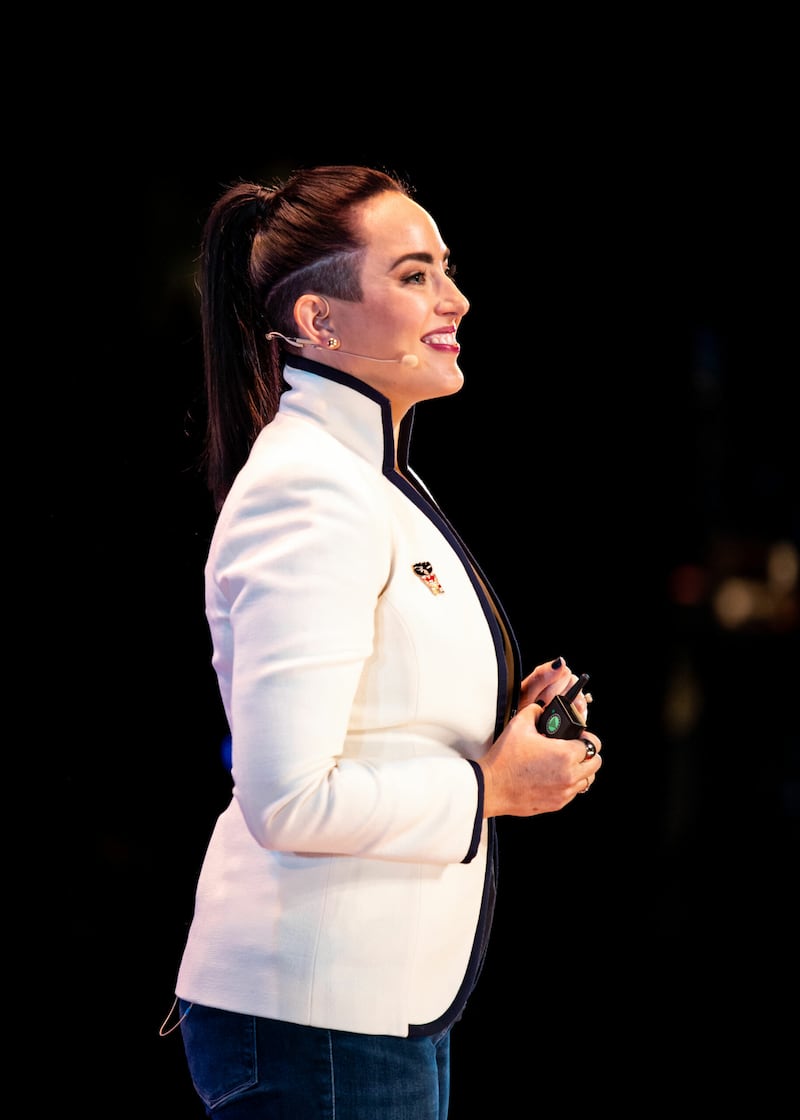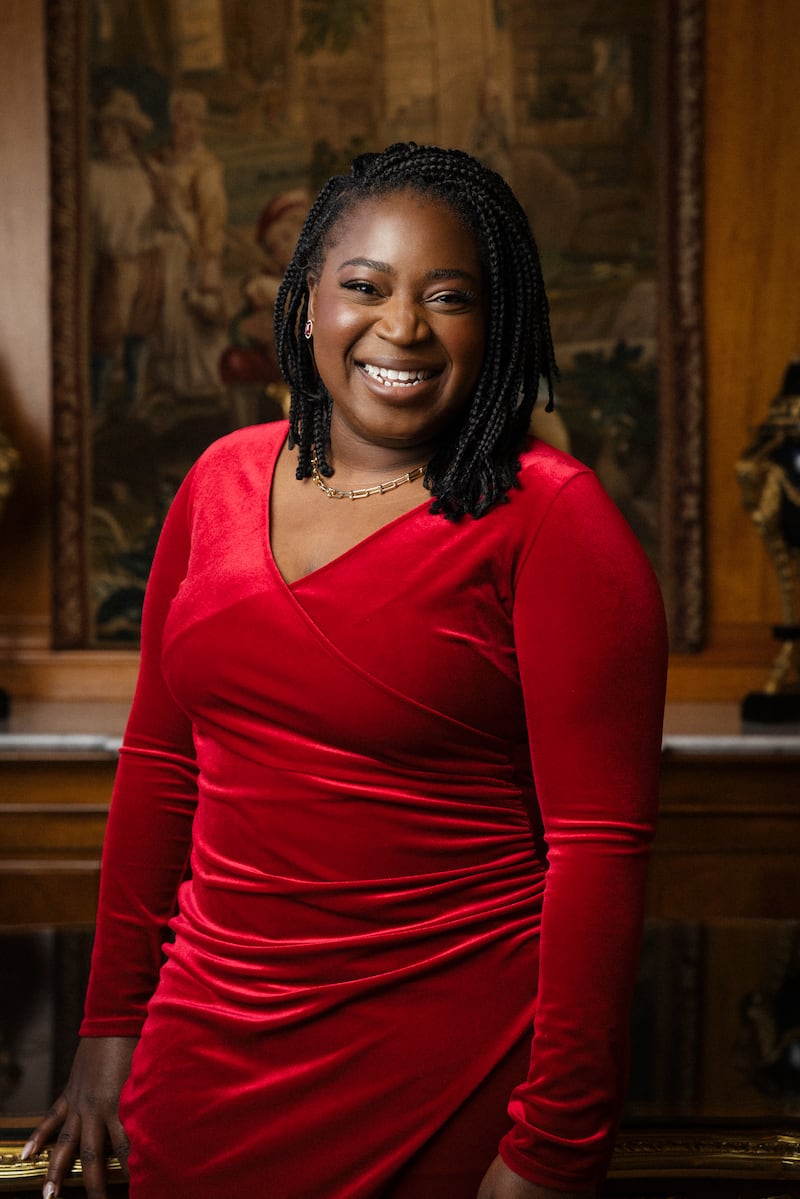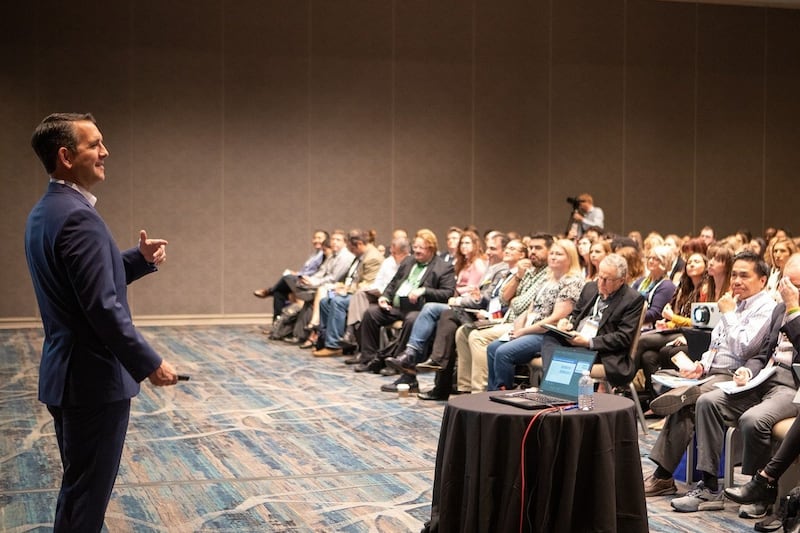
Dr. Chelsea Shields | Photo by Jon Hague, Courtesy of TEDxSaltLakeCity
This article features hand-picked marketing experts who will present at Utah Business Forward. With five distinct tracks covering entrepreneurship, international business, marketing, people & culture and strategy, this dynamic event will be hosted on November 16, 2023, at the Grand America Hotel in Salt Lake City. Click here to learn more about the event.
In an early episode of “Mad Men,” Don Draper pitches to the cigarette company Lucky Strike. He tells the tobacco execs, “Advertising is based on one thing: happiness.”
Draper goes on to describe the philosophy defined in the 1960s through the 1980s, an era sometimes referenced as “the Golden Age of Advertising.” This kind of mass-market messaging worked well for companies in that era, partly because consumers had more faith in the vision of contentment and ease that companies were selling.
“Do you know what happiness is? Happiness is the smell of a new car. It’s freedom from fear,” Draper continues in his pitch. “It’s a billboard on the side of a road that screams with reassurance that whatever you’re doing is okay. You are okay.”
Dr. Chelsea Shields, owner of the Brandthropologie Agency, a customer experience research and performance brand strategy company in Salt Lake City, says this old-school philosophy no longer works for today’s marketers. It’s not because people stopped buying stuff in the pursuit of happiness—that trend is still going strong.
It’s because of one massive shift since the days of “Mad Men”: loss of consumer trust.
“There used to be trust in the family, trust in the government, trust in medicine, religion, corporations, brands, military—you name it,” Dr. Shields says. “There was trust in our infrastructure and our basic social systems. There was trust in almost everything we did. All of that is gone.”
The research proves Dr. Shields’ point: consumer trust has plummeted, especially after the COVID-19 pandemic. According to a recent Gallup poll, confidence in major institutions, including banks, big business and tech corporations, has steadily declined and particularly tanked in the last three years.
Without trust, companies can’t sell the masses a bright, shiny, homogenous picture of happiness. They struggle to sell anything at all.
Lack of trust is not the only hurdle facing post-“Mad Men” marketers. During the Golden Age of Advertising, mass marketing was the name of the game. And it was a game with fewer players on a smaller field.
“It’s not as easy as it was in the 1950s and 1960s to get consumer attention,” says Melissa Garcia, expert-in-residence at the Product Marketing Alliance. “Back then, a shampoo company might have had a handful of other major competitors. They just had to make their product seem sexy and fun to stick in customer’s minds.”
In short, companies could succeed with a business-first mindset. Garcia says that businesses still try to rely on mass-marketing tactics, but today’s landscape is much more complex. That shampoo company isn’t just competing with other brands of shampoo. It’s competing against every Instagram ad, email newsletter and retargeting ad vying for customers’ attention.
“That’s the biggest challenge in marketing. You’re trying to position your product in somebody’s mind, to create a memory, to connect to a need. When there’s so much out there, at some point, a customer isn’t going to have anything left to view your ad,” Garcia says.
In this new age of marketing defined by increased competition, fragmented attention and decreased trust, how can companies connect with customers?

Melissa Garcia
Know thyself—and thy audience
First, move away from a business-first, mass-marketing mindset. Today’s marketing needs to be real, bold and simple to cut through the skepticism and the noise.
To create authentic content, businesses need to know who they are and who they are talking to. If a company isn’t anchored in its values, differentiators and mission, its messaging may come off as insincere or hackneyed.
Dr. Shields compares this generic marketing to scrolling through Tinder. There are a hundred profiles of singles who claim to be fun, kind and in love with hiking. Who will stand out from the crowd?
“The photo of a guy sitting at a drumset with the caption, ‘I love to rock.’ He may not be for everyone, but everyone will immediately understand who he is,” Dr. Shields says.
A company who knows who it is will be as easy for its ideal customer to understand as the rocker. It’ll produce marketing rooted in what the company has to offer, its differentiators, and what it stands for. Once a company understands who it is, the company can understand who is most likely to swipe right.
Who that ideal (real) audience is may be surprising, says Michelda George, founder and CEO of Versatile Image. She emphasizes the importance of market research and talking to customers to dig into who they actually are—not just who the marketing team thinks they might be.
“Don’t be afraid to ask your customers questions to truly understand them,” George says. “You have to earn people’s money and trust by getting them on a deeper level. Your business is here to serve people. Those people are human. They have real-life scenarios, real-life challenges. They have real-life thoughts and feelings.”
Garcia agrees. “It’s about making the customer the hero,” she says. “Jump on some calls, listen to some sales calls, ask questions. Talk to your customer service teams, to your sales teams. Really understanding what your customers’ pain points are is critical to delivering an experience that speaks to them.”
In short, once companies know who they are and who they are talking to, they can say something directly to their audience—and mean it.
Be bold on purpose
As customers have grown less trusting, companies have grown more cautious. They are afraid to use their marketing to make a statement. “Everyone is out there saying the same thing. To establish trust, you have to say something different,” Dr. Shields says. “Be bold, but be bold on purpose.”
She gives the example of Amazon’s “Stress Less, Smile More.” It is simple and easy to read, remember and repeat. It is a universally desired sentiment around the world. It gets at their primary value of convenience but from the customer’s primary benefit point of view. “Amazon is great at making the customer the hero. It’s always about them, not the company.”
There’s a common misconception that marketing messages aren’t getting through because people are distracted, George says. But, in reality, consumers are paying a lot of attention to companies like Amazon who are doing it right. They are choosing how to spend their attention just like they’re choosing how to spend their money.
Garcia says an integral part of grabbing that attention is personalization. “Once you become the expert on your customers, you’re able to deliver highly relevant, timely and meaningful content to the right people at the right time through the right channel with the right messaging.”

Michelda George | Photo by Ori Media
Tap the power of artificial intelligence
The tricky part of this kind of highly targeted, responsive messaging is that it takes a whole lot of work. Don Draper performed his advertising magic and devised the Lucky Strike motto on the spot. It was sent out to their audience (America) over two channels (magazines and billboards).
In contrast, a personalized omnichannel marketing campaign requires as many unique messages as there are audience segments and as many different variations of that message as there are channels.
A bespoke shampoo company, for example, may have a hundred defined targeted audience segments (curly-haired moms of teenagers, fine-haired single 20-somethings in urban areas, etc.) that they reach through 30 different channels (email marketing, Instagram sponsored content, YouTube ads, TikTok influencers, text message campaigns, etc.).
The sheer labor involved in such a campaign is many magnitudes greater than Draper’s. Michael Smart, CEO of MichaelSMARTPR, points out that one impediment to genuine, targeted storytelling is simply time. Marketers often have competing obligations, such as a demand for commodity content, production-based marketing goals and the repetitive maintenance of an omnichannel strategy. These tear them away from implementing the ideal practices.
Today’s marketing teams simply can’t do it all alone. “A single marketer only has so much storytelling energy,” Smart says. “Finding a story takes time. When they have six blog posts to write in a week, stopping to sift through a hundred customer stories often isn’t possible.”
This is where artificial intelligence (AI) comes in. While AI cannot (yet) write the kind of personalized, empathetic and nuanced marketing messaging that today’s audiences need, generative AI is a goldmine for analyzing data, streamlining busywork and giving marketers back some of that valuable creative time.
“I can take the support chats, feed those into the AI, and have it identify what patterns emerged. I can have it pull customer quotes based on themes, common use cases and satisfaction level,” Smart says. “By saving time on research and pinpointing the most valuable data in seconds, I’ll have more time to write the stories that matter.”
Garcia values the power of AI and machine learning in assisting directly with marketing personalization. “Over time, through collecting and analyzing customer data, these tools can prescribe an experience. This makes our marketing less reactive.”
When George looks toward the future, she sees marketing evolving into a democratizing societal force. As AI saves people time and money and as more companies begin to tell real, raw stories, she sees competition giving way to more cooperation. This, in turn, will help to reestablish consumer trust.
“Marketing is an opportunity to connect. Looking toward the future, it won’t be one-size-fits-all,” George says. “There will be room for everyone to grow. We can all win.”

Michael Smart

